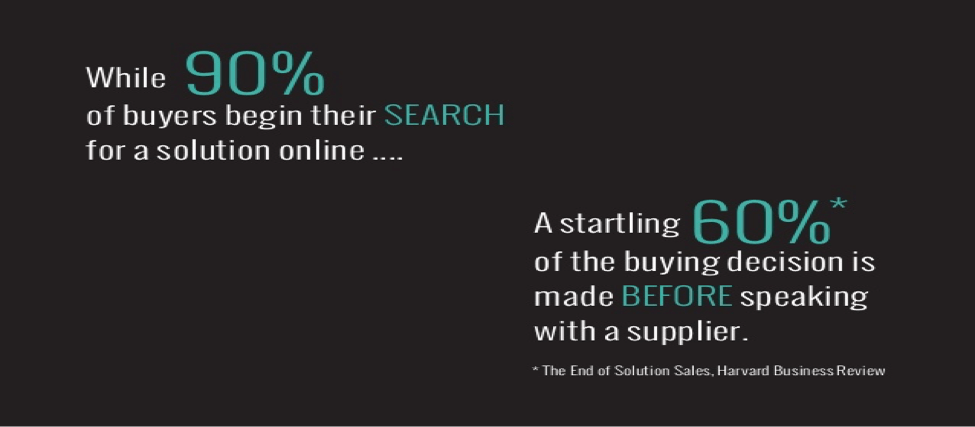Business to Business Marketing: The Digital Revolution
Business to Business Marketing has embraced Digital in much the same as its consumer counterpart
One of my first jobs after graduating from college was working as an Industrial Sales Rep for a couple of years. The job involved selling different types of weighing equipment to a wide variety of end users. I sold everything from heavy duty weighbridges used in the quarrying/transport industry to highly sensitive “parts counter” calibrated to milligrams used by pharma and electronics companies. I had responsibility for certain industries or as some people like to say “verticals!” and most weeks I drove in excess of 800 miles in my little Grey Volkswagen Diesel Golf.
This was the mid eighties and the use of technology and computers let alone the World Wide Web was like something from a Sci Fi movie. The average value of a sale was often quite large perhaps 15,000 to 20,000 thousand pounds in those days. I had some repeat business but mostly my job involved winning new business through what I called “proactive prospecting” and Lead Generation. In today’s Digital speak this would mean that I had to keep filling the top of my sales funnel on an ongoing basis.
In simple terms I had to identify potential new companies and individuals on an ongoing basis that might be interested in buying my weighing equipment either short term or sometime in the future.
Sales Pipeline
This building on my “sales pipeline“ was all done on a manual basis. Firstly I had to identify a list of companies that were in one of the industry sectors I had responsibility for. This was usually done by “very scientific” means which usually involved getting the Yellow Pages and listing all the companies under the various industry headings. On the odd occasion it may have been necessary to spend a few days in the library of the Irish Trade Board in Dublin search through directories and then putting the photocopy machine into near meltdown.
When I had my handwritten or photocopied list of “targets” complied it was back to my desk in the office where I set about making contact. This process usually involved a number of “high level strategic” steps. Firstly it necessitated a phone call to the company to establish who the key contact was. In most cases I had only a company name, address and phone number. This meant I had to convince the receptionist of my “bona fides” and that I had to something very important to offer that could save their company zillions! In the first instance I was only looking for a name was was usually a buyer in a large multinational or perhaps an owner manager in a smaller business.
Interest, Desire, Action
When I had identified a list of contact name I then set about drafting my letter of introduction to be posted in a large A4 envelope along with one of our 10,000 new glossy brochures (9,000 of which were never used) I always put a lot of thought into this letter. Our marketing Professor told us to follow the AIDA principle. This meant trying to get to get the prospect’s Attention in the first instance and creating some Interest. This was usually done by referring to the brochure with all the product features and associated benefits which could save the company Zillions! This helped to create Desire followed by the desired Action which meant “In theory” they couldn’t wait to contact me to get a demo or set up a meeting to discuss things in more detail. On the odd occasion that the phone did ring it was like winning the Lotto and I couldn’t wait jump in my VW Golf to drive the 150 miles to meet the company and the buyer. Sometimes the need was genuine but more often it was about getting three quotations or checking out something for a production manager or boss. This often meant a second or a third trip and sometime I had to pull in my “boss” to try and get the deal over the line, particularly if it was near the end of a quarter or year end.
I usually tried to send out maybe 15/20 letters and brochures to new prospects each week usually on a Monday. This process had to be staggered because each company had to be phoned in advance to get the key contact name and then about 5 days after the letter was posted I called again. The purpose of the second call was to try and get a conversation with what I thought was the key contact and hopefully determine what the level of potential interest was and the timeline involved.
Don’t forget I still had to drive my 800 mile per week on average to meet with contacts who I may have spoken to two or three weeks previously. I was a tough but enjoyable gig. Many nights spent in hotels and chasing up and down the country in my VW Golf looking to meet targets and get my bonus. Of course our company also attended to the odd exposition and took out some ads in industry magazines but this was where the heavy lifting and primary Lead Generation activity was done. We had no fancy CRM systems and all sales reports had to be filled on a weekly basis by hand. Once a month I met with my boss to review my reports and look at my “Sales Pipeline”. This was often a nerve wrecking experience because I was often trying to repeat verbatim what the prospect had said. “It was only a matter of time before we got the order”, maybe he was waiting on a Purchase order or his boss was sick and couldn’t sign off. Sometimes at the last minute other people would get involved in the decision making process and the order would be delayed again and again. I was usually relieved for a few days when they meeting was over but then my mind soon turned to the next sales meeting and a new set of conversations to be remembered.
This was how business to business marketing was done then and still was up until a few years ago. Don’t get me wrong there still is and probably always will be a need for sales reprs driving around in their Ford Mondeo’s or VW Passat’s. But now it’s time to work smart and embrace the Digital Revolution.
At Emarkable we get to work with a lot of great companies helping them to grow their revenue through digitally enabled strategies. It’s not a one size fits all approach and every strategic challenge is unique. It’s important to get the balance right between the traditional outbound type approach outlined above and the newer digitally focused Inbound Marketing approach. This is about attracting the potential prospects to your online presence through the use of tactics such as SEO, Content marketing etc.
The balance between the two approaches is critical because the modern B2B buyer often has a different mindset and approach than previous incumbents.
In the first instance the growth of Social channels and the explosion of web content have meant that buyers are overwhelmed with information.
It is becoming increasingly difficult to gain their attention in a positive or meaningful way. This is what calls The Battle for Mindshare. Modern B2B buyers are now empowered to carry out their own research and over 72% of them will start their research with typing some search terms into Google.
The B2B Customers Initial Search

Research by analysts like McKinsey, Accenture, and Forrester etc tell us that these “self empowered buyers” are often 60-90% down the decision making process before they even engage with VW Golf or Mondeo man and his company. In effect this means that for over two thirds of the buying process your prospects are out there on their own forming opinions, learning technical specifications, and drawing up shortlist of potential vendors.

This new reality is a game changer in the B2B buying process. As a result many organisations are realigning their Lead Generation and Marketing strategy approach to take cognisance of this.
At Emarkable we work with organisations to help them embrace the opportunity created by the B2B buyer of today. We will make sure that your website is found on Google and that you are attracting the right type of visitors to your website.
We help you to convert these website visitors into potential Sales Leads by encouraging them to leave contact details in exchange for downloading content. We help you to identify buying signals by monitoring online behaviours and advise you how to move your prospects down the buyer journey.
Emarkable will help you to scale up your Marketing activities by assisting in content creation which is the currency of the web. We will show you the best software and platforms to use to integrate your marketing and sales activities along at every stage of the buyer journey. Contact us to arrange a meeting.
We will help your company work smarter and make sure that Mondeo man not only meets but exceeds his targets year on year.


